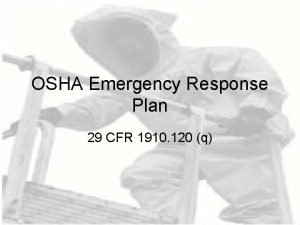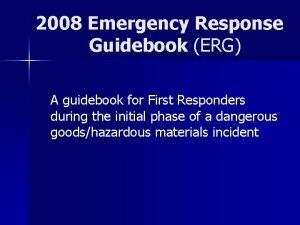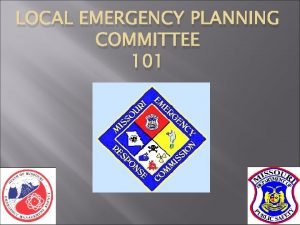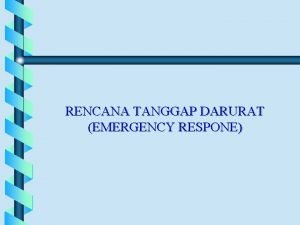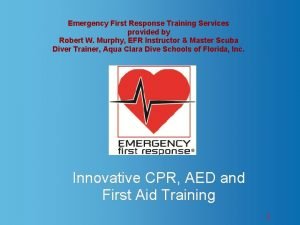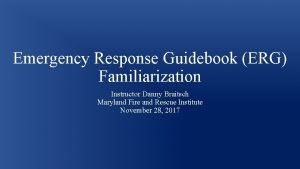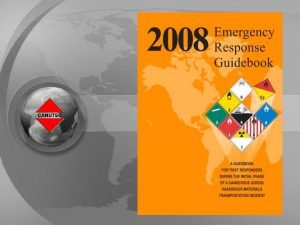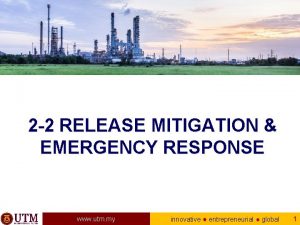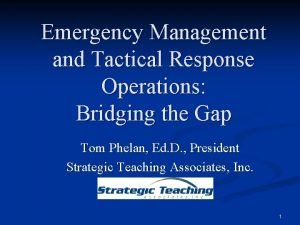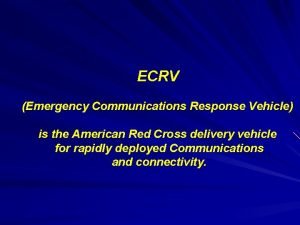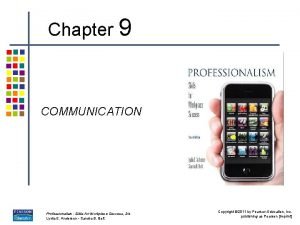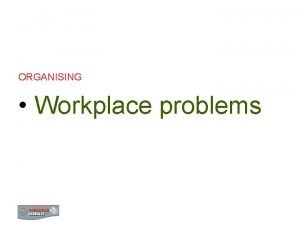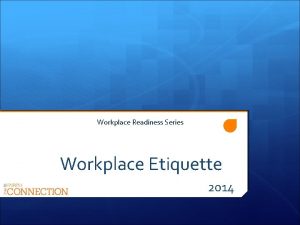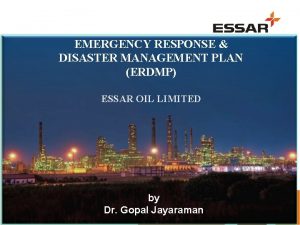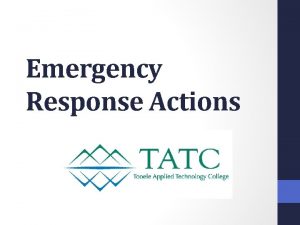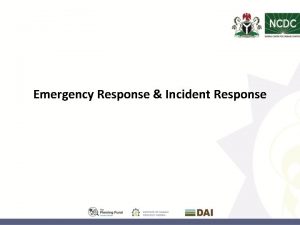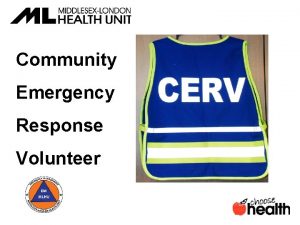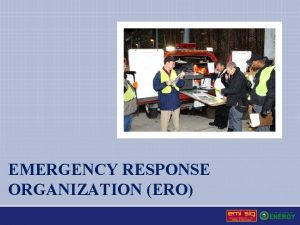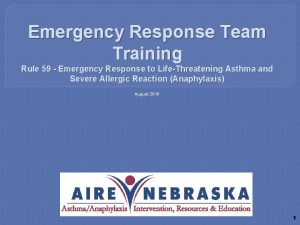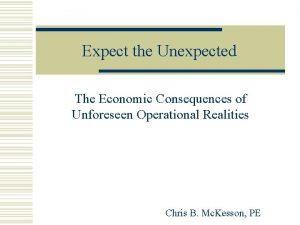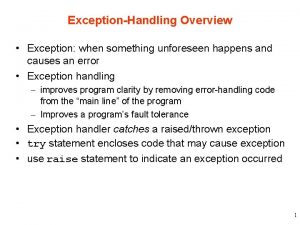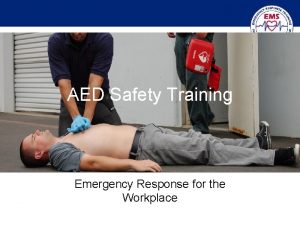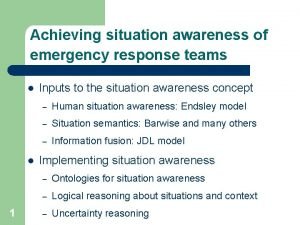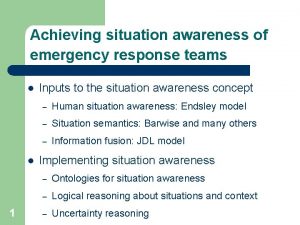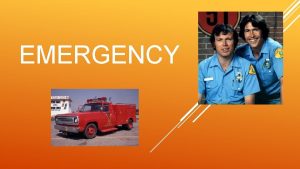Emergency Response Workplace Emergency An unforeseen situation that


































- Slides: 34

Emergency Response

Workplace Emergency An unforeseen situation that threatens your employees, customers, or the public, disrupts or shuts down your operations, or causes physical or environmental damage.

Types of Emergency • Earthquakes • Hurricanes • Tornadoes • Energy/utility outages • Fire hazards • Hazardous materials releases • Terrorism

Workplace Emergency Reporting and alerting emergencies • Employees must know how to report emergencies • "911" is a common method for reporting emergencies if external emergency personnel are used at your workplace

Workplace Emergency OSHA’s Recordkeeping and Reporting • Fatality: Death of one or more employees from a workrelated incident • Catastrophe: In-patient hospitalization of three or more employees as a result of a work-related incident

Emergency Preparedness Essential elements of emergency preparedness planning: • Identify hazards and assess risk. • Assess capabilities and resources. • Develop an emergency plan and procedures. • Integrate the plan with the community plan. • Conduct training. • Public relations. • Conduct Drills and Exercises. • Develop Plan Audit Procedures.

OSHA’s Response Plans • National Emergency Management Plan (NEMP) • Regional Emergency Management Plan (REMP)

OSHA’s Response to Emergency • To assist local response agencies in any way possible within agency capabilities (Non-enforcement) • To initiate workplace investigation (Enforcement)

Non-enforcement role vs. Enforcement World Trade Center after 9 -11 Construction site

Incident Command System INCIDENT COMMANDER SAFETY INFORMATION LIAISON OPERATIONS PLANNING LOGISTICS FINANCE/ ADMINISTRATION

OSHA Requirements for Emergency Response and Preparedness in Construction Industry 29 CFR 1926

OSHA Requirements for Emergency Response and Preparedness in Construction Industry 29 CFR 1926 General Requirements for all Workplaces q 29 CFR 1926. 23: First Aid and Medical attention, and q 1926. 50: Medical services and first aid Procedures: – Ensure medical personnel is available for consultation and advice on occupational health matters – Provide suitable facilities for quick drenching and flushing of the eye Training: – In the absence of readily accessible medical services, a person with a valid certificate in first aid training

OSHA Requirements for Emergency Response and Preparedness in Construction Industry 29 CFR 1926 Additional Requirements for Workplaces referenced in other standards q 29 CFR 1926. 35: Employee emergency action plan Procedures: – Prepare and implement a written action plan that includes: • Emergency escape procedures • Procedures for those who remain to conduct critical operations • Means of reporting fires and emergencies • Procedures to account for employees after the emergency Training: – Review emergency action plan with each employee when the plan is developed, responsibilities shift, or the emergency procedures change. – Provide specific training to employees who are expected to assist in evacuation

OSHA Requirements for Emergency Response and Preparedness in Construction Industry 29 CFR 1926 General Requirements for all Workplaces q 29 CFR 1926. 34: Means of egress Procedures: – Maintain unobstructed egress from every building and structure where employees are working – Mark all exits with signs and mark access to exits where it is not immediately apparent how to exit

OSHA Requirements for Emergency Response and Preparedness in Construction Industry 29 CFR 1926 General Requirements for all Workplaces q 29 CFR 1926. 24: Fire protection and prevention, q 1926. 150: Fire protection q 1926. 151: Fire prevention Procedures: – Develop fire protection program – Provide fire extinguishers and other firefighting equipment Training: – If a fire brigade is necessary, adequately train them.

OSHA Requirements for Emergency Response and Preparedness in Construction Industry 29 CFR 1926 Additional Requirements for Specific Workplaces/Operations q 29 CFR 1926. 64: PSM of highly hazardous chemicals q 29 CFR 1926. 65: Haz. Woper, Emergency response to hazardous substance releases

OSHA Requirements for Emergency Response and Preparedness in Construction Industry 29 CFR 1926 Additional Requirements for Specific Workplaces/Operations q 29 CFR 1926. 651: Specific excavation requirements Procedures: – Provide emergency rescue equipment when an excavation contains or potentially contains a hazardous atmosphere – Ensure that person(s) attend the equipment in case of emergency. – Provide and ensure the use of a safety harness and lifeline when employee(s) perform work in bell-bottom pier holes or similar deep and confined footing excavations

OSHA Requirements for Emergency Response and Preparedness in Construction Industry 29 CFR 1926 Additional Requirements for Specific Workplaces/Operations q 29 CFR 1926. 800: Underground construction Procedures: – Develop and maintain a check -in/check-out procedure – Provide means to summon emergency assistance – Ensure monitoring is performed – Select, provide, and make available approved selfrescuers Training: – Instruct employees on fire prevention and emergency procedures – Ensure rescue teams are familiar with jobsite conditions – Qualify rescue team members at least annually

OSHA Requirements for Emergency Response and Preparedness in Construction Industry 29 CFR 1926 Additional Requirements for Specific Workplaces/Operations q 29 CFR 1926. 950: Power Transmission and Distribution Procedures: – Provide spotlights or portable lights for emergency lighting when needed to work safely at night Training: – Provide training and ensure that employees understand emergency procedures and first aid fundamentals, including CPR

Exposure to silica dust in construction work

OSHA Requirements for Emergency Response and Preparedness in Construction Industry 29 CFR 1926 Requirements that Support Emergency Response and Preparedness q 29 CFR 1926. 55: Gases, vapors, fumes, dust, and mists Procedures: – Ensure that employee exposures do not exceed the limits provided by the standard. – Exposures should be limited through engineering controls, administrative controls, and, as a last resort, PPE q 29 CFR 1926. 59: Hazard Communication q 29 CFR 1926. 103: Respiratory Protection q 29 CFR 1926. 1103: 13 Carcinogens q 29 CFR 1926. 1117: Vinyl chloride

OSHA Requirements for Emergency Response and Preparedness in Construction Industry 29 CFR 1926 Additional Requirements for Specific Workplaces/Operations q 29 CFR 1926. 60: Methylenedianiline (MDA) Procedures: – Develop and implement a written plan for emergency situations where there is a possibility of an emergency: • Identify emergency escape routes before construction begins • Equipped employees with PPE and clothing until emergency is abated • Include elements prescribed in 1910. 38 and 1910. 39 Training: – Provide employees with info and training on MDA, IAW 1910. 1200(h) – Ensure employees who must wear respiratory protection, receive training as per 1910. 134

OSHA Requirements for Emergency Response and Preparedness in Construction Industry 29 CFR 1926 Health Hazard Related Standards: Cadmium (Cd) q 29 CFR 1926. 1127: Cadmium – Wrecking, demolishing, and salvaging structures –Cutting, brazing, grinding, or welding Procedures: –Develop and implement a written plan –Select and provide appropriate respirators for emergencies Training: –Provide training to include emergency procedures, prior to/at the time of initial assignment to a job involving potential exposure to Cd –Ensure employees who must wear respiratory protection receive training (29 CFR 1910. 134) DANGER. . . CADMIUM. . . CANCER HAZARD. . . CAN CAUSE LUNG AND KIDNEY DISEASE. . . AUTHORIZED PERSONNEL ONLY. . . RESPIRATORS REQUIRED IN THIS AREA

OSHA Requirements for Emergency Response and Preparedness in Construction Industry 29 CFR 1926 Requirements that Support Emergency Response and Preparedness q 29 CFR 1926. 28: Personal Protection Equipment (PPE) q 29 CFR 1926. 95: Criteria for PPE Procedures: – Provide and ensure the use and maintenance of appropriate PPE for site operations and hazards – Ensure any employeeowned equipment is adequately and properly maintained

III – Recovery strategies §Recovery strategies are based on MTDs §Predefined §Management-approved

III – Recovery strategies §Different technical strategies §Different costs and benefits §How to choose? §Careful cost-benefit analysis §Driven by business requirements

III – Recovery strategies §Strategies should address recovery of: • Business operations • Facilities & supplies • Users (workers and end-users) • Network, data center (technical) • Data (off-site backups of data and applications)

III – Recovery strategies §Technical recovery strategies - scope • Data center • Networks • Telecommunications

III – Recovery strategies §Technical recovery strategies – methods • Subscription services • Mutual aid agreements • Redundant data centers • Service bureaus

III – Recovery strategies §Technical recovery strategies – subscription service sites • Hot – fully equipped • Warm – missing key components • Cold – empty data center • Mirror – full redundancy • Mobile – trailer full of computers

III – Recovery strategies §Technical recovery strategies – mutual aid agreements • I’ll help you if you’ll help me! • Inexpensive • Usually not practical

III – Recovery strategies §Technical recovery strategies – redundant processing centers • Expensive • Maybe not enough spare capacity for critical operations

III – Recovery strategies §Technical recovery strategies –service bureaus • Many clients share facilities • Almost as expensive as a hot site • Must negotiate agreements with other clients

III – Recovery strategies §Technical recovery strategies –data • Backups of data and applications • Off-site vs. on-site storage of media • How fast can data be recovered? • How much data can you lose? • Security of off-site backup media • Types of backups (full, incremental, differential, etc. )
 Unforeseen transactional risk
Unforeseen transactional risk Con hãy đưa tay khi thấy người vấp ngã
Con hãy đưa tay khi thấy người vấp ngã Thơ thất ngôn tứ tuyệt đường luật
Thơ thất ngôn tứ tuyệt đường luật Tôn thất thuyết là ai
Tôn thất thuyết là ai Ngoại tâm thu thất chùm đôi
Ngoại tâm thu thất chùm đôi Walmart thất bại ở nhật
Walmart thất bại ở nhật Gây tê cơ vuông thắt lưng
Gây tê cơ vuông thắt lưng Block nhĩ thất độ 1
Block nhĩ thất độ 1 Tìm vết của mặt phẳng
Tìm vết của mặt phẳng Sau thất bại ở hồ điển triệt
Sau thất bại ở hồ điển triệt Thơ thất ngôn tứ tuyệt đường luật
Thơ thất ngôn tứ tuyệt đường luật General alarm in ship
General alarm in ship Ercp emergency response
Ercp emergency response Emergency response tool
Emergency response tool Osha emergency response plan
Osha emergency response plan Erg green section
Erg green section Sing cert
Sing cert Missouri emergency response commission
Missouri emergency response commission Contoh rencana tanggap darurat
Contoh rencana tanggap darurat Walmart emergency response system
Walmart emergency response system The importance of training
The importance of training Erg green section
Erg green section Orange section erg
Orange section erg Emergency response plan
Emergency response plan Utm emergency response plan
Utm emergency response plan Emergency disaster tactical response
Emergency disaster tactical response Ecrv
Ecrv Natural and forced response
Natural and forced response Natural response circuit
Natural response circuit Primary immune response and secondary immune response
Primary immune response and secondary immune response Offensive language in the workplace
Offensive language in the workplace Items that distort or prevent communication
Items that distort or prevent communication Workplace readiness skills
Workplace readiness skills Knife safety in the workplace
Knife safety in the workplace Hukum perbedaan individu
Hukum perbedaan individu














